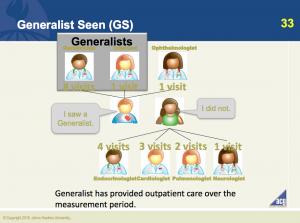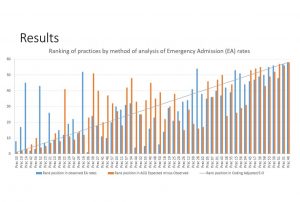Documents
Documents
Abstract Objectives: This study examined how frailty in traditional risk-adjusted models could improve the predictability of unplanned 30-day readmission and mortality among heart failure patients. […]
Abstract Purpose To address the extent to which Federally Qualified Health Centers (FQHCs) and independent and provider-based Rural Health Clinics (RHCs) were using telehealth prior […]
To deliver on the promise of high-quality, value-based care for our patients in the context of workforce shortages and an aging population, risk stratification is […]
Background The Health Equity Payment (HEP) scheme was developed by population health leads from NHS Leicester, Leicestershire and Rutland (LLR) Integrated Care Board (ICB), intended […]
Abstract Importance The Johns Hopkins Community Health Partnership was created to improve care coordination across the continuum in East Baltimore, Maryland. Objective To determine whether the Johns […]

This webinar will provide an overview of the data available within the ACG System to support case finding activities. The topics covered will include the […]

Presented by: Dr. David Shepherd FRCGP
This webinar shares a case study of Leicester CCG in the UK. The ACG System was used to analyze emergency admission rates for all practices in the area. The top 8 practices were identified and studied further to understand key characteristics of those practices.
BMC Health Serv Res 14:363. McMaster University, Hamilton, ON, Canada BACKGROUND: Health system planners aim to pursue the three goals of Triple Aim: 1) reduce […]
Med Care 39:86-99. Centre for Health Services and Policy Research, University of British Columbia, Vancouver, BC, Canada BACKGROUND: While the adjusted clinical group (ACG) system […]
Med Care 52:157-163. Department of Health Policy and Management, Johns Hopkins University, Baltimore, MD, USA BACKGROUND: Health care quality is frequently described with measures representing […]
Med Care 39:692-704. Center for Health Quality, Outcomes and Economic Research, Bedford VAMC, MA, USA BACKGROUND: Diagnosis-based case-mix measures are increasingly used for provider profiling, […]
JAMA Intern Med Johns Hopkins University, Baltimore, MD, USA Importance: Both the overuse of unnecessary medical procedures and poor continuity of care are thought to […]
JAMA Pediatr 170:148-154. Children’s Hospitals and Clinics of Minnesota, Minneapolis, MN, USA IMPORTANCE: Little is known about the effect of pediatric accountable care organizations (ACOs) […]
Int J Palliat Nurs 21:349-356. McMaster University, Hamilton, ON, Canada BACKGROUND: Little is known about residents of long-term care (LTC) facilities who die of cancer. […]
J Subst Abuse Treat 57:30-35. University of Toronto, ON, Canada; Institute for Clinical Evaluative Sciences, Toronto, ON, Canada; St. Michael’s Hospital, Toronto, ON, Canada; St. […]
J Am Med Inform Assoc 22:435-442. Weill Cornell Medical College, New York, NY, USA BACKGROUND: Hospital readmissions are common, costly, and offer opportunities for utilization […]
Pediatr Pulmonol 47:211-219. British Columbia’s Children’s Hospital, Vancouver, BC, Canada Given the difficulties in diagnosing, or even defining, asthma in children, claims of a pediatric […]
Med Care 37:238-248. Astrabudúa Health Center, Osakidetza/Basque Health Service, Bizkaia, Spain BACKGROUND: Ambulatory Care Groups (ACGs), a US case mix system that uses the patient […]
Int J Qual Health Care 8:231-241. Department of Psychiatry, University of Pittsburgh, Pittsburgh, PA, USA Most studies of ambulatory care quality are based on chart […]
Bone 40:1595-1601. Department of Medicine, University of Manitoba, Winnipeg, MB, Canada Diabetes is associated with increased fracture rates but the effect size, time course and […]
Chronic Dis Can 30:46-55. University of British Columbia, Faculty of Pharmaceutical Sciences, Vancouver, BC, Canada To date there has been little investigation of the prevalence […]
Am J Prev Med 42:390-397. Group Health Permanente, University of Washington Medical School, Seattle, WA, USA BACKGROUND: Many trials have tested different strategies to increase […]
Osteoporos Int 23:2381-2386. Division of General Internal Medicine, McGill University Health Center, Montreal, QC, Canada Institutionalization after hip fracture occurs in at least 30% of […]
Annu Rev Public Health 20:125-144. Department of Biostatistics, University of Washington, Seattle, WA, USA Important questions about health care are often addressed by studying health […]
Osteoporos Int 22:2439-2448. Division of General Internal Medicine, McGill University Health Center, Montreal, QC, Canada Non-traumatic fractures at typical osteoporotic sites are associated with increased […]
PLoS One 7:e32141. Multiprofessional Education Unit for Family and Community Care (Southwest), Madrid, Spain INTRODUCTION: Healthcare management is oriented toward single diseases, yet multimorbidity is […]
JAMA 279:853-858. Department of Health Services, University of Washington, Seattle, WA, USA CONTEXT: Growth of at-risk managed care contracts between health plans and medical groups […]
Eff Clin Pract 1:66-72. Center for Health Research, Kaiser Permanente, Northwest Division, Portland, OR, USA. Health care information technology is changing rapidly and dramatically. A […]
J Am Geriatr Soc 54:330-334. Department of Health Policy and Management, Bloomberg School of Public Health, School of Medicine, Johns Hopkins University, Baltimore, MD, USA […]
Am J Manag Care 18:e155-161. Department of General Practice and Health Services Research, University Hospital Heidelberg, Heidelberg, Germany. OBJECTIVES: The identification of patients most likely […]
J Trauma Acute Care Surg 74:26-30; discussion 30-1. Li Ka Shing Knowledge Institute, St Michael’s Hospital; and Institute for Clinical Evaluative Science, Toronto, ON, Canada […]
JAMA 285:2223-2231. Department of Health Policy and Management, Johns Hopkins School of Hygiene and Public Health, Baltimore, MD, USA CONTEXT: Most health maintenance organizations offer […]
Health Aff 21:89-102. Health Systems Management Faculty, School of Public Affairs, University of Baltimore, Baltimore, MD, USA. This paper presents the first empirical analysis of […]
Health Serv Manage Res 20:134-139. Department of Family Medicine, Mayo Clinic, Rochester, MN, USA Open-access or advanced-access scheduling, which opens the clinic calendar to patients […]
Aten Primaria 40:603-610. Published in Spanish. Dirección de Planificación. Badalona Serveis Assistencials, S.A. Badalona. Barcelona, Spain OBJECTIVE: To evaluate the co-morbidity, health care use, economical […]
Health Policy 97:122-129. Centre for Health Services and Policy Research, University of British Columbia, Vancouver, BC, Canada OBJECTIVE: We examined changes in patterns of benzodiazepine […]
Pediatrics 108:906-912. Center for Child and Adolescent Health Policy, MassGeneral Hospital for Children, Boston, MA, USA OBJECTIVE: To estimate generalist, pediatric subspecialist, and any subspecialist […]
Med Care 49:257-266. Faculty of Medicine, University of Calgary, Calgary, AB, Canada BACKGROUND: Administrative databases are increasingly being used to study the incident dialysis population […]
BMC Fam Pract 13:26. Department of Family and Community Medicine, University of Toronto, Toronto, ON, Canada BACKGROUND: There are continued concerns over an adequate supply […]
J Eval Clin Pract 18:1170-1179. Badalona Serveis Assistencials, Badalona, Barcelona, Spain OBJECTIVE: To compare the cost of adding either pregabalin or gabapentin to the management […]
J Clin Epidemiol 66:436-444. Population Health Research Centre, Division of Population Health Sciences and Education, St George’s University of London, London, UK OBJECTIVES: Adjustment for […]
Obesity 21:1328-1334. Division of General Internal Medicine, Department of Medicine, Johns Hopkins University School of Medicine, Baltimore, Maryland, USA. OBJECTIVE: Negative interactions with healthcare providers […]
Can Fam Physician 59:384-390. Lamont Primary Health Care Research Centre, Bruyère Research Institute, Ottawa, ON, Canada Erratum in: Can Fam Physician. 2013 Jun;59(6):612. OBJECTIVE: To […]
Br J Gen Pract 63:534-542. Department of Primary Care and Public Health (DPCPH), Imperial College London, London, UK BACKGROUND: More accurate and recent estimates of […]
JAAPA 27:45-49. Duke University School of Medicine, Durham, NC; Veterans Affairs Pittsburgh Healthcare System and University of Pittsburgh School of Pharmacy, Pittsburgh, PA; University of […]
Health Care Financ Rev 17:23-42. Project HOPE Center for Health Affairs, Bethesda, MD, USA Variations in elderly Medicare beneficiaries’ health service use are examined using […]
BMC Health Serv Res 7:A8. Johns Hopkins Bloomberg School of Public Health, Baltimore, MD, USA; Imperial College London, UK Aim: The goal of this project […]
New York, NY, USA: Springer. Johns Hopkins Health Care, Glen Burnie, MD, USA Strong data management knowledge and skills are a requirement for every DNP. […]
London, UK: National Health Service. National Health Service. London, UK This handbook describes current thinking and provides practitioner insights into case finding and risk stratification […]
Windsor, UK: NHS Slough Clinical Commissioning Group. NHS Slough Clinical Commissioning Group, Windsor, UK As our population ages and the prevalence of long term conditions […]
Advance Newsmagazines, King of Prussia, PA, USA More than two years ago when Dave Ford took over as CEO at CareOregon in Portland, Ore., the […]
Clin Med Res 8:51-52. Maccabi Healthcare Services, Tel Aviv, Israel BACKGROUND: With an ever increasing population of HMO members with chronic disease and continuing economic […]
Winnipeg, MB, Canada: Manitoba Centre for Health Policy. Manitoba Centre for Health Policy, University of Manitoba, Winnipeg, MB, Canada Many Manitobans have a chronic disease—indeed […]
Cambridge, MA, USA: Harvard University School of Public Health. Harvard University School of Public Health, Cambridge, MA, USA A key component of many recent proposals […]
Washington, DC, USA: NRH Center for Health and Disability Research. NRH Center for Health & Disability Research, Washington, DC, USA As a group, people with […]
Schaumburg, IL, USA: Society of Actuaries. Japanese translation published by Tokyo Gakugei University. Society of Actuaries, Schaumburg, IL, USA This Society of Actuaries research project […]
Academia Economic Papers 28:231-261. Published in Chinese. PURPOSE: To explore risk factors that can explain individual medical expenditure. SAMPLE: Subjects included in “1996 NHI Satisfaction […]
Baltimore, MD, USA: University of Maryland (doctoral dissertation). University of Maryland, Baltimore, MD, USA The National Institutes of Health (NIH) define a health disparity as […]
European Neuropsychopharmacology 19:S340-S341. Badalona Serveis Assistencials SA, Directorate ofPlanning, Badalona. Barcelona, Spain BACKGROUND: Prescription drug costs are rapidly increasing in most countries. The pharmaceutical expenditure […]
Barcelona, Spain: Universitat Politecnica de Catalunya (masters thesis). Published in Catalan. Universitat Politecnica de Catalunya, Spain No abstract
BMC Health Serv Res 11:A22. Institute for Clinical Evaluative Sciences, Toronto, ON, Canada INTRODUCTION: A number of different blended-payment models for primary- care delivery have […]
Seattle, WA, USA: University of Washington (doctoral dissertation). University of Washington, Seattle, WA, USA Originally described in 1967 as a central source of a medical […]
Victoria, BC, Canada: Hollander Analytical Services Ltd. This report constitutes a synthesis of findings from the evaluation of the Full Service Family Practice Incentive Program […]
Odense, Denmark: Syddansk Universitet. Published in Danish. Syddansk University, Odense, Denmark Dette arbejdspapir er udarbejdet af Forskningsenheden for Almen Praksis (FEA) og Center for Sundhedsøkonomisk […]
National Yang Ming University A Population-based Study of the Effect of Free Influenza Vaccination on Medical Utilization of Elderly Taiwanese Ching Wen Chien, Ph.D.
NHS Midlands and Lancashire Commissioning Support Unit Population Level Risk Stratification to Support Strategic Planning and Commissioning
The Creation of New Models to Predict Future Resource Use and Risk of Hospital Admission for a General Population in NHS England —Stephen Sutch, Johns […]
Development of the case finding tool using the ACG system Kevin Roberts

Preventing avoidable hospital readmissions is considered by many to be the most important opportunity for reducing waste in health care. This podcast explains readmissions and why identifying these at-risk patients is important to health plans. Learn more.

This Case Study shows how Leicester City CCG, one of the most ethnically diverse areas of the UK, analyzed emergency admission rates for all practices, to learn that practices with lower emergency admission rates had significantly higher coding completeness and GP patient survey scores. Learn more.
Background: A small number of people with chronic obstructive pulmonary disease (COPD) receive pulmonary function testing around the time of diagnosis. Because omitting testing increases […]
Abstract Background: Using electronic health records (EHRs), in addition to claims, to systematically identify patients with factors associated with adverse outcomes (geriatric risk) among older […]
Abstract Background: Hidradenitis suppurativa (HS) is a chronic debilitating disease with long-lasting comorbidities that impose direct and indirect costs on the health care system. However, […]
Abstract Background Pain is more common among people living with HIV (PLWH) than their counterparts; however, it is unclear whether analgesic use differs by […]
Abstract Primary Health Networks (PHNs) are tasked to enhance the efficiency and effectiveness of general practice. Gold Coast Primary Health Network (GCPHN) has been collecting […]
Abstract Background Physical therapy (PT) is an accepted standard of care after total joint arthroplasty (TJA) and essential to maximizing joint functionality and minimizing complications […]
Abstract Background The Johns Hopkins ACG System is widely used to predict patient healthcare service use and costs. Most applications have focused on adult populations. […]
Abstract Background The majority of new hepatitis C (HCV) cases occur among people who inject drugs. In recent years, multidisciplinary models of HCV treatment have […]
Abstract Background Currently, 11% of patients seen in the emergency department for atrial fibrillation die within 1 year of the visit. Our objective was to […]
Abstract Objectives To identify and summarise existing indices for measuring multimorbidity beyond disease counts, to establish which indices include mental health comorbidities or outcomes, and […]
Abstract While an increasing number of girls and women are being identified with autism, we know little about the health of reproductive-aged autistic women. Our […]
Abstract Objectives To determine the impact of frailty on postoperative readmission, morbidity, and mortality among patients undergoing surgery for endometrial cancer. Methods Patients with endometrial […]
Abstract Background Type 2 diabetes mellitus (T2D) is often accompanied by chronic diseases, including mental health problems. We aimed at studying mental health comorbidity prevalence […]
Abstract OBJECTIVE Pituitary adenomas (PAs) are among the most common intracranial tumors. Understanding the clinical effects of various modifiable risk factors (MRFs) and nonmodifiable risk […]
Abstract Aims To describe the impact of diabetes comorbidities on the health care services use and costs of a cohort of elderly patients with diabetes […]
Abstract Hypothesis There is limited data on the care and outcomes of individuals with both chronic obstructive pulmonary disease (COPD) and lung cancer, particularly in […]
Abstract Background: A standard measure of the cancer diagnostic pathway, diagnostic interval, is the time from “first presentation of cancer” to diagnosis. Cancer presentation may be […]
Abstract Objective Frailty has been shown to portend worse outcomes in surgical patients. Our goal was to identify the impact of frailty on outcomes and […]
Abstract Background Frailty aggregates a composite of geriatric and elderly features that is classified into a singular syndrome; literature thus far has proven its influence […]
Abstract Introduction This study assesses the risk of infection and clinical outcomes in a large consecutive population of cancer and non-cancer patients tested for SARS-CoV-2 […]
Abstract Objectives To examine the impact of time to surgery (TTS) on survival among patients with stage I non-small cell lung cancer (NSCLC). Methods All […]
Abstract Background The progressive ageing in developed countries entails an increase in multimorbidity. Population-wide predictive models for adverse health outcomes are crucial to address these […]
Abstract Background Hepatitis C virus (HCV) infection is associated with reduced quality of life and health utility. It is unclear whether this is primarily due […]


